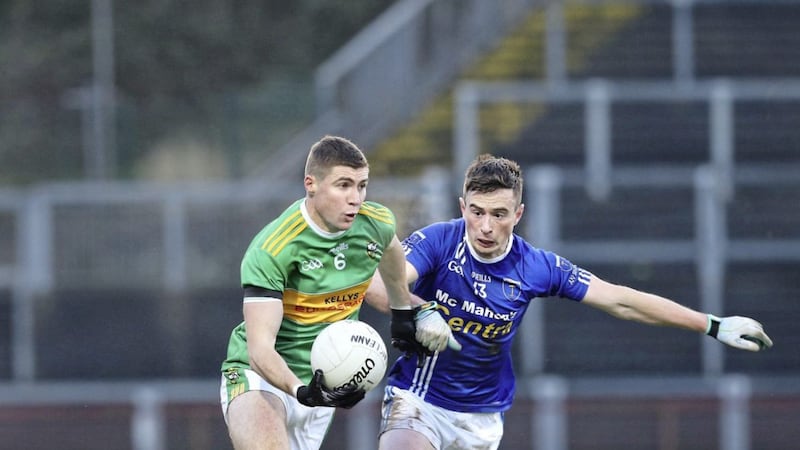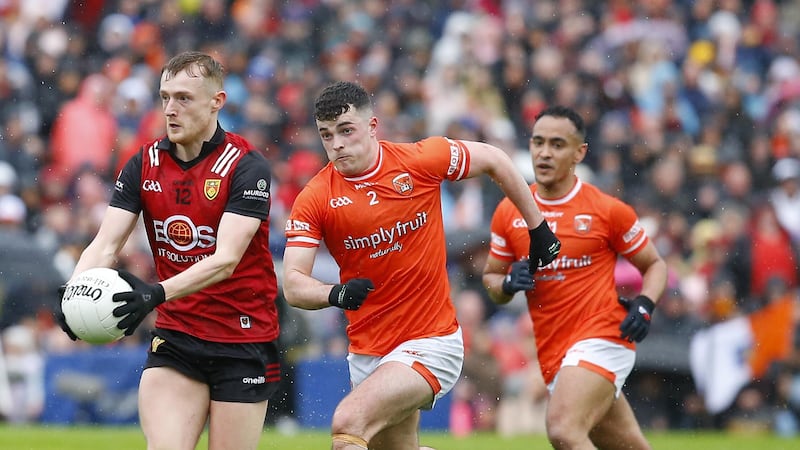WHEN Kerry beat Dublin in the 1975 All-Ireland final, Kevin Moran was sitting watching it in Mulligan’s bar on Poolbeg Street, its back touching the Liffey.
He could have gone out and walked to Croke Park but he and his mates were content, and by the end of it glad they didn’t bother.
Twelve months later, Dublin would win the All-Ireland with Kevin Moran wearing the number six shirt and winning man-of-the-match.
In ’77 they won another, and then he was gone off to Manchester United, the haze of his brilliance fading all-too-quickly on a Dublin generation that would thereafter find themselves left behind by their Kingdom brethren.
There was nothing archetypal about the way he played at centre-back.
In the first attack of the ’76 final, he was a human chainsaw taken to Kerry’s defence. A simple one-two and his pace cuts them wide open. That the drop-kick whistled wide is all that denied him a place on the eternal showreel.
It was a glimpse into the future.
Pre-1975, and for a lot of the post-Moran years too, there was a particular make-up to the great sixes.
The likes of Kerry’s John Cronin and Tim Kennelly, Dublin’s Jim Crowley and Paddy Holden, Down’s Dan McCartan, Offaly’s Nicholas Clavin and Seán Lowry were all renowned as ferocious defenders who protected their goal as though it was their last pound coin.
That in itself was a skill.
Great number sixes have always been born, not made.
Others could run around like headless chickens and get away with it on account of a bit of panache and the odd save-the-day moment.
But the good centre-halves had to be steady.
They had to play well every week and for that, their reading of the game had to be exemplary.
There were added points for being slow-footed yet making an artform out of just knowing exactly where to be.
Being too young to fully appreciate a peak Henry Downey, the first six I truly loved was Seamus Moynihan.
You’d be noticing this spindly-looking character drowned in his ‘90s Adidas top, looking like he was made of nothing yet mincing big men if they dared enter his territory, and then burning them on the way out.
These were still the follow-your-man-to-the-toilet times but Moynihan had the ability to both shut down the great centre-forwards and protect his goal at all costs too.
‘How does he know where to be?’ you'd find yourself wondering.
It helped that he could play too.
Kieran McGeeney could play as well but it was the combination of defensive brain, brawn and bravery that made him essential to the Armagh cause.
Sweepers changed the role. It became someone else’s job to mark the centre of the goal. In some ways, it diluted the defensive importance of having a great stopper at six.
When Paul Kimmage went to meet Kevin Moran at home in England in 2015, the former Dublin dynamo remarked how much the game has changed.
“The formations now. I remember the first time I went over to see Donegal play and you almost thought you were watching a soccer game! I thought, 'Wow! Everybody is behind the ball. How are Dublin going to break that down?'”
He would have been the walking answer had he still been playing.
The old centre-forward is dead, eaten alive. The Greg Blaneys and Brian McGuigans are not coming back.
Anyone playing there hasn’t room to turn a sweet in their mouth, and the men inside that they once serviced have even less.
Centre-back is now where the game starts rather than where it ends.
When St Vincent’s moved Diarmuid Connolly back there two years ago, it felt like the natural answer to the modern defensive conundrum.
Whereas the game is played now in the space that centre-forwards used to have to themselves, it’s all in front of your centre-back. He’s the man with the space now.
Malachy O’Rourke hasn’t won what he’s won without recognising that.
Whatever about Conor Glass coming home and getting Danny Tallon inside and making a county player out of Michael Warnock, the single biggest thing he’s done is put Ciaran McFaul to six.
McFaul has been consistently the best player in Derry, at club and county level, for five years.
That’s what makes him a prime number six. He’ll not hide or go missing. And because he’s in constant demand of the ball, teams have to deal with him.
Different opponents have tried different ideas. In Derry, almost everyone did what Scotstown did and went about their own business by trying to put a forward on him that could hurt him going the other way.
Nobody laid a glove on him.
St Eunan’s put corner-back Aaron Deeney up on him and it worked for a half, but McFaul figured it out and ran the second period.
Glen’s entire game is run from their half-back line. McFaul sees the game in front of him and with the ability to kick big scores from big distances, he is the threat with which Kilcoo must deal in two weeks’ time.
Six is the new eleven.
Nobody is providing stronger evidence than Ciaran McFaul.







